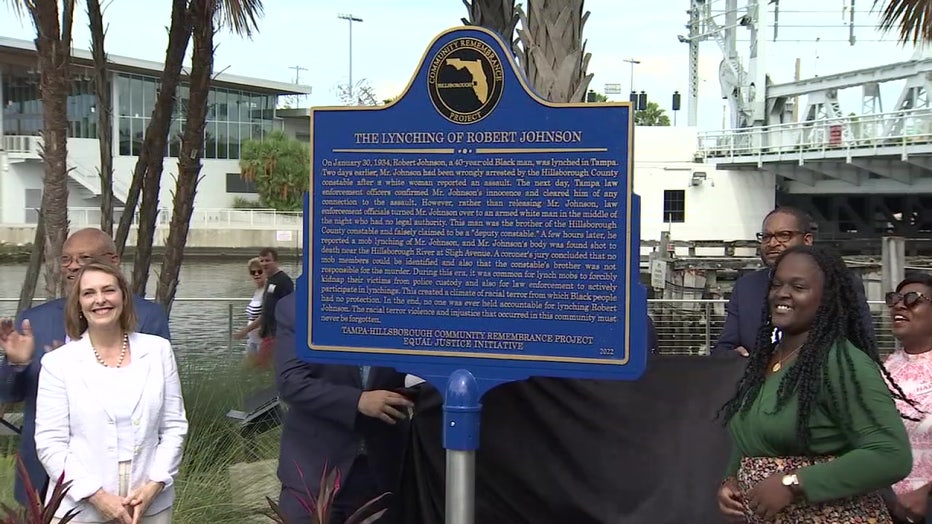'His life matters': Marker for Tampa lynching victim set up along Riverwalk

Marker to remember lynching victim set up along Riverwalk
Tampa's Riverwalk is lined with markers and busts that tell the city's rich history and share the stories of some of its most-well known residents.
TAMPA, Fla. - Tampa's Riverwalk is lined with markers and busts that tell the city's rich history and share the stories of some of its most-well known residents. On Monday, a little-known name was added among the past mayors and movers and shakers that left their marks on the city.
His name was Robert Johnson. He was murdered by a lynch mob in Tampa in 1934.
Though his death made headlines and even inspired calls for justice from then-Florida Governor Dave Scholtz, no one was ever held accountable for Johnson's murder and his name soon faded from memory, until now.
A new marker along the Riverwalk ensures Johnson's name, and Tampa's uncomfortable history of lynching and racial terror, is not forgotten.
Johnson's image and life story have been lost to history but his death, reported widely in newspapers at the time, is an unfortunately familiar story in the Jim Crow south. Johnson, a Black man, was accused of assaulting a white woman.
RELATED: New historic marker on Riverwalk will shine light on lynching victim, Tampa's dark past
Though he was quickly cleared of the charges, authorities in Tampa allowed him to be released into the hands of an angry white mob. Within a half hour of his unusual overnight release from jail, Johnson was found shot to death on the banks of the Hillsborough River.
"I always say that history like this is a challenge to us, because it speaks to what is wrong with America that can be fixed by what’s right with America," said Tampa City Councilman Luis Viera, who played an integral role in the marker's creation. "Americans tend to be very optimistic people, and I think that when we see a lynching marker like this we can reflect upon the idea that it’s a challenge for us today to do right to recognize all of our history and to do better in terms of fighting for justice and equity in our own time and dealing with that acute and unresolved history which is painful for many Americans today."
As with many victims of lynchings, local law enforcement played a hand in Johnson's slaying. According to newspaper reports from 1934, Johnson was released into the custody of a "deputy constable" at 2:35 a.m.
It was later revealed that the "deputy", identified as T.M. Graves and the brother of the Hillsborough County constable, indeed had no legal authority and had falsely claimed to be a member of law enforcement. Graves reported he was set upon by a mob of lynchers and forced to accompany them. His gun is believed to have been the murder weapon.

Despite this, a jury found him to have not been at fault for Johnson's killing.
For former Tampa Police Chief and current Mayor Jane Castor, the marker is an important reckoning for the role local law enforcement frequently played in racially motivated crimes of the time.
"In some cases, the law enforcement agency may have been complicit in these killings, so we have to understand that history and that past to develop the collaboration and the working relationships that we need today to ensure that Tampa remains one of the safest cities in our nation and that we value and appreciate each member of our community," said Castor.
Attendees at the marker's unveiling ceremony on Monday said that telling Johnson's story is an important step forward for Tampa.
"It’s hard for me to put it into words without becoming emotional. It means that instead of giving lip service to our diversity, Tampa has taken action," said Gloria Jean Royster, who lives in downtown Tampa. "This is that symbol that all lives matter and that’s what we need to remember and that is what we need to aspire to."
MORE: Some residents push to add 'Dobyville' to Hyde Park's historic district
Johnson is one of five known African American lynching victims in Hillsborough County.
The marker, located on the Riverwalk near Doyle Carlton Drive and W. Laurel Street, sits on land previously owned by Fortune Taylor, a formerly enslaved woman who later in life became a prominent landowner and entrepreneur in downtown Tampa.
To Royster, the juxtaposition of Johnson and Taylor's stories helps tell a more complete version of Tampa's complicated history.
"This is actually a positive story that’s being told today. Look where we are. This is a bridge and a street named for a Black woman in Tampa. That’s a positive story, but so is recognizing Robert Johnson’s life. His life matters."

